SUMMARY CMI
Tobrex® Eye Drops and Eye Ointment 0.3%
Consumer Medicine Information (CMI) summary
The full CMI on the next page has more details. If you are worried about using this medicine, speak to your doctor or pharmacist.
1. Why am I using Tobrex Eye Drops and Eye Ointment?
Tobrex Eye Drops and Eye Ointment contain active ingredient Tobramycin. Tobrex Eye Drops and Eye Ointment is used to treat certain infections of external part of eye caused by bacteria.
For more information, see Section 1. Why am I using Tobrex Eye Drops and Eye Ointment? in the full CMI.
2. What should I know before I use Tobrex Eye Drops and Eye Ointment?
Do not use if you have ever had an allergic reaction to Tobrex Eye Drops and Eye Ointment or any of the ingredients listed at the end of the CMI.
Talk to your doctor if you have any other medical conditions, take any other medicines, or are pregnant or plan to become pregnant or are breastfeeding.
For more information, see Section 2. What should I know before I use Tobrex Eye Drops and Eye Ointment? in the full CMI.
3. What if I am taking other medicines?
Some medicines may interfere with Tobrex Eye Drops and Eye Ointment and affect how it works.
A list of these medicines is in Section 3. What if I am taking other medicines? in the full CMI.
4. How do I use Tobrex Eye Drops and Eye Ointment?
- Your doctor will advise you regarding your dose.
- Use Tobrex Eye Drops and Eye Ointment as prescribed by your doctor.
- Consult your doctor or pharmacist if you do not understand your dose.
More instructions can be found in Section 4. How do I use Tobrex Eye Drops and Eye Ointment? in the full CMI.
5. What should I know while using Tobrex Eye Drops and Eye Ointment?
| Things you should do |
|
| Things you should not do |
|
| Driving or using machines |
|
| Looking after your medicine |
|
For more information, see Section 5. What should I know while using Tobrex Eye Drops and Eye Ointment? in the full CMI.
6. Are there any side effects?
Common side effects include eye and eyelid itching, eye discomfort, burning and stinging sensation of the eyes, dry eye, feeling that something is in your eye(s).
For more information, including what to do if you have any side effects, see Section 6. Are there any side effects? in the full CMI.
FULL CMI
Tobrex® Eye Drops and Eye Ointment 0.3%
Active ingredient: Tobramycin
Consumer Medicine Information (CMI)
This leaflet provides important information about using Tobrex Eye Drops and Eye Ointment. You should also speak to your doctor or pharmacist if you would like further information or if you have any concerns or questions about using Tobrex Eye Drops and Eye Ointment.
Where to find information in this leaflet:
1. Why am I using Tobrex Eye Drops and Eye Ointment?
2. What should I know before I use Tobrex Eye Drops and Eye Ointment?
3. What if I am taking other medicines?
4. How do I use Tobrex Eye Drops and Eye Ointment?
5. What should I know while using Tobrex Eye Drops and Eye Ointment?
6. Are there any side effects?
7. Product details
1. Why am I using Tobrex Eye Drops and Eye Ointment?
Tobrex Eye Drops and Tobrex Eye Ointment contain the active ingredient Tobramycin. It belongs to a class of drugs called Aminoglycoside antibiotics.
Tobrex Eye Drops and Tobrex Eye Ointment are used to treat certain infections of the external part of eye caused by bacteria. They help to kill the bacteria that cause infections.
2. What should I know before I use Tobrex Eye Drops and Eye Ointment?
Warnings
Do not use Tobrex Eye Drops and Eye Ointment:
- If you are allergic to Tobramycin, or any of the ingredients listed at the end of this leaflet. Always check the ingredients to make sure you can use this medicine.
- If you are allergic to other aminoglycosides drugs e.g. Neomycin
Symptoms of allergic reaction may include:
Check with your doctor if you:
- have any neuromuscular problems such as myasthenia gravis (chronic disorder characterized by weakness in the skeletal muscles, which worsens with activity) or Parkinson's disease (a movement disorder of the nervous system that worsens over time) as it may worsen muscle weakness.
- have any other medical conditions.
- take any other aminoglycoside antibiotics e.g. Neomycin.
- take any medicines for any other condition.
During treatment, you may be at risk of developing certain side effects. It is important you understand these risks and how to monitor for them. See additional information under Section 6. Are there any side effects?
Pregnancy and breastfeeding
Check with your doctor if you are pregnant or intend to become pregnant.
Your doctor will advise you regarding the possible risks and benefits of using Tobrex Eye Drops and Eye Ointment during pregnancy.
Talk to your doctor if you are breastfeeding or intend to breastfeed.
Your doctor will advise you regarding the possible risks and benefits of using Tobrex Eye Drops and Eye Ointment during breast feeding.
3. What if I am taking other medicines?
Tell your doctor or pharmacist if you are taking any other medicines, including any medicines, vitamins or supplements that you buy without a prescription from your pharmacy, supermarket or health food shop.
Some medicines may interfere with Tobrex Eye Drops and Eye Ointment and affect how it works.
Tell your doctor if you take any of the following medicines:
Antibiotics like beta lactam type which are used to treat infections of the ear, eye or the skin
Medicines that can lead to hearing loss.
Other aminoglycoside antibiotics that are like tobramycin.
Check with your doctor or pharmacist if you are not sure about what medicines, vitamins or supplements you are taking and if these affect Tobrex Eye Drops and Eye Ointment.
4. How do I use Tobrex Eye Drops and Eye Ointment?
How much to use
- Follow the instructions provided when Tobrex Eye Drops and Eye Ointment were prescribed, including the number of days it should be taken.
- Consult your doctor or pharmacist if you do not understand your dose.
- The usual duration of treatment with Tobrex Eye Drops and Eye Ointment is 7-10 days.
Tobrex Eye Drops:
- For mild to moderate infection: put one or two drops into the affected eye(s) every four hours.
- For serious infection: put two drops into the eye(s) hourly until improvement.
Tobrex Eye Ointment:
- For mild to moderate infection: apply a 1 - 1.5 cm ribbon into the affected eye(s) two or three times per day.
- For serious infection: apply a 1 - 1.5 cm ribbon every three to four hours until improvement.
When to use Tobrex Eye Drops and Eye Ointment
- Tobrex Eye Drops and Eye Ointment should be used as prescribed by your doctor.
How to use Tobrex Eye Drops and Eye Ointment
Follow the steps below to use Tobrex Eye Drops:
- Sitting or lying down might make putting in your eye drops simpler.
- Remove contact lenses if you are wearing them before putting in the eye drops.
- Shake the bottle well prior to use.
- Wash your hands thoroughly with soap and water.
- Before using a bottle for the first time, break the safety seal around the neck area and throw the loose plastic ring away.
- Remove the cap from the bottle.
- After the cap is removed, if a tamper evident snap collar is present and loose, remove before using the eye drops.
- Mix the contents of the bottle by inverting 5 to 10 times.
- Hold the bottle upside down in one hand between your thumb and middle finger (see Diagram 1).
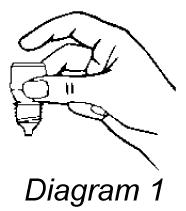
- Tilt your head back, gently pull down the lower eyelid of your eye to form a pouch/pocket.
- Place the tip of the bottle close to your eye. Do not touch the tip to your eye as this may cause injury to the eye.
- Do not touch the dropper tip to your eyelid or surrounding areas or any surface to avoid contamination of the dropper tip and solution.
- Release one drop into the pouch/pocket formed between your eye and eyelid by gently tapping or pressing the base of the bottle with your forefinger (see Diagrams 2 and 3).
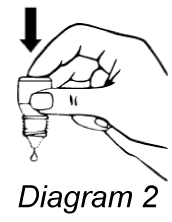

- Gently close your eye. Do not blink or rub your eye.
- When your eye is closed, place your index finger against the inside corner of your eye and press against your nose for about two minutes. This will help to prevent the medicine from draining through the tear duct to the nose and throat, from where it can be absorbed into other parts of your body and may result in a decrease in side effects.
- This will also help to reduce the unpleasant taste sensation that some people experience when using these drops.
- If necessary, repeat the above steps for the other eye.
- You may feel a slight burning sensation in the eye shortly after using Tobrex Eye Drops. If it persists, or is uncomfortable, contact your doctor or pharmacist.
- If you want to use any other eye drops wait at least 5 minutes after putting in Tobrex Eye Drops.
- It is normal for a small amount of eye drops to spill onto your cheek since your eyelids can only hold less than one drop at a time. Wipe away any spillage with a tissue.
- Replace the cap on the bottle, closing it tightly.
- Always keep the bottle tightly closed when not in use.
- Wash your hands again with soap and water to remove any residue. - Discard the Tobrex Eye Drops after 4 weeks after opening it.
- Wait for 15 minutes before replacing your contact lenses.
Follow the steps below to use Tobrex Eye Ointment:
- Wash your hands completely with soap and water.
- Remove the cap from the tube. Using your forefinger, gently pull your lower eyelid down to form a pouch (see Diagram 1).
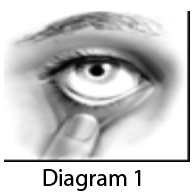
- With the help of your other hand, carefully squeeze a small ribbon (about 1 to 1 1/2 cm) of ointment into the pouch (see Diagram 2).
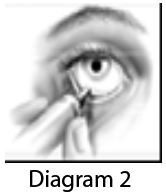
- Slowly close your eye without blinking ensuring that the ointment remains within the eye (see Diagrams 3 and 4

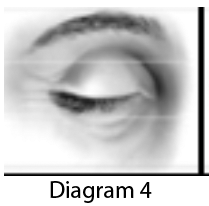
- Close your eye for 1 to 2 minutes.
- If necessary, repeat the above steps 1-4 for your other eye.
- Place the cap on the tube and close it tightly.
- Wash your hands again with soap and water to remove any residue.
- You might feel a slight burning sensation in the eye shortly after using the ointment. If it continues, or is very uncomfortable, contact your doctor or pharmacist.
- Do not touch the tip of the ointment tube with your fingers, the eye or anything else.
- This will help to prevent eye ointment from becoming contaminated.
- Wait at least 5 minutes before putting any other eye drops or ointment in your eye(s) after treatment with Tobrex Eye Drops and Eye Ointment.
- Wait for 15 minutes before replacing your contact lenses.
- Discard the Tobrex Eye Ointment after 4 weeks after opening it.
If you forget to use Tobrex Eye Drops and Eye Ointment
Tobrex Eye Drops and Eye Ointment should be used as prescribed by your doctor. If you miss your dose at the usual time, use it as soon as you remember, and then go back to using it as you would normally.
If it is almost time for your next dose, skip the dose you missed and take your next dose when you are meant to.
Do not take a double dose to make up for the dose you missed.
If you use too much Tobrex Eye Drops and Eye Ointment
If you think that you have used too much Tobrex Eye Drops or Eye Ointment, you may need urgent medical attention.
You should immediately:
- phone the Poisons Information Centre
(by calling 13 11 26), or - contact your doctor, or
- go to the Emergency Department at your nearest hospital.
You should do this even if there are no signs of discomfort or poisoning.
If you have accidentally used several Tobrex Eye Drops or too much Eye Ointment in your eyes, immediately wash your eyes with lukewarm water.
5. What should I know while using Tobrex Eye Drops and Eye Ointment?
Things you should do
- Tobrex Eye Drops and Eye Ointment are for Eye use only.
Call your doctor straight away if you:
- develop any signs of an allergic reaction.
- become pregnant or if you are breast feeding while using Tobrex Eye Drops and Eye Ointment.
- take any other aminoglycoside antibiotics.
Remind any doctor, dentist, pharmacist or specialist you visit that you are using Tobrex Eye Drops or Eye Ointment.
Things you should not do
- Do not stop using this medicine suddenly.
- Do not use Tobrex Eye drops and Eye Ointment while wearing contact lenses.
Tobrex Eye Drops contain benzalkonium chloride which may cause eye irritation and discolour soft contact lenses. The ointment base used in Tobrex Eye Ointment may be difficult to clean off your lenses. - You can put your contact lenses back into your eye 15 minutes after you have used Tobrex Eye drops or Eye Ointment.
- Do not give Tobrex Eye drops and Eye Ointment to anyone else, even if they have the same condition as you.
- Do not use Tobrex Eye drops and Eye Ointment in children less than 12 months of age.
Driving or using machines
Be careful before you drive or use any machines or tools until you know how Tobrex Eye drops and Eye Ointment affects you.
Tobrex Eye drops and Eye Ointment may cause temporary blurred vision or other eye problems.
If blurred vision occurs after using Tobrex Eye Drops or Tobrex Eye Ointment, wait until the vision clears before driving or using machinery.
Looking after your medicine
- Store below 25°C.
- Do not freeze.
Follow the instructions in the carton on how to take care of your medicine properly.
Store it in a cool dry place away from moisture, heat or sunlight; for example, do not store it:
- in the bathroom or near a sink, or
- in the car or on window sills.
Keep it where young children cannot reach it.
When to discard your medicine
- Discard Tobrex Eye drops and Eye Ointment 4 weeks after opening it.
Getting rid of any unwanted medicine
If you no longer need to use this medicine or it is out of date, take it to any pharmacy for safe disposal.
Do not use this medicine after the expiry date.
6. Are there any side effects?
All medicines can have side effects. If you do experience any side effects, most of them are minor and temporary. However, some side effects may need medical attention.
See the information below and, if you need to, ask your doctor or pharmacist if you have any further questions about side effects.
Less serious side effects
| Less serious side effects | What to do |
Eye problems:
| Speak to your doctor if you have any of these less serious side effects and they worry you. |
Serious side effects
| Serious side effects | What to do |
Eye problems:
| Call your doctor straight away or go straight to the Emergency Department at your nearest hospital if you notice any of these serious side effects. |
Tell your doctor or pharmacist if you notice anything else that may be making you feel unwell.
Other side effects not listed here may occur in some people.
Reporting side effects
After you have received medical advice for any side effects you experience, you can report side effects to the Therapeutic Goods Administration online at www.tga.gov.au/reporting-problems. By reporting side effects, you can help provide more information on the safety of this medicine.
Always make sure you speak to your doctor or pharmacist before you decide to stop taking any of your medicines.
7. Product details
This medicine is only available with a doctor's prescription.
What Tobrex Eye Drops and Eye Ointment contain
| Active ingredient (main ingredient) | Tobramycin |
| Other ingredients (inactive ingredients) | Tobrex (tobramycin) Eye Drops contain boric acid, sodium sulfate, sodium chloride, tyloxapol, sodium hydroxide and/or sulphuric acid (to adjust pH) and purified water. Each mL of Tobrex Eye Drops contains benzalkonium chloride 0.01% (0.1 mg) as preservative. Tobrex (tobramycin) Eye Ointment contains mineral oil and petroleum base. Each gram of Tobrex Eye Ointment contains chlorobutanol 0.5% (5 mg) as preservative. |
| Potential allergens | Soya beans |
Do not take this medicine if you are allergic to any of these ingredients.
What Tobrex Eye Drops and Eye Ointment looks like
Tobrex (tobramycin) Eye Drops comes in a 5 mL LDPE bottle with PP closure.
Tobrex (tobramycin) Eye Ointment comes in a 3.5 g aluminium tubes with HDPE and/or LDPE nozzle.
Australian Registration Numbers:
Tobrex Eye Drops 3mg/ml AUSTR 25365
Tobrex Ointment 3mg/g AUSTR 25364
Who distributes Tobrex Eye Drops and Eye Ointment
Novartis Pharmaceuticals Australia Pty Limited
ABN 18 004 244 160
54 Waterloo Road
Macquarie Park NSW 2113
Telephone: 1-800-671-203
Web site: www.novartis.com.au
This leaflet was prepared in May 2025.
Internal document code:
(tox201123c_v2) based on PI (tox201123i)
Published by MIMS July 2025

 Chemical name: 4-O-(3-amino-3-deoxy-α-D-glucopyranosyl)- 2-deoxy-6-O-(2,6-diamino-2,3,6-trideoxy- α-D-ribo-hexopyranosyl)-L-streptamine.
Chemical name: 4-O-(3-amino-3-deoxy-α-D-glucopyranosyl)- 2-deoxy-6-O-(2,6-diamino-2,3,6-trideoxy- α-D-ribo-hexopyranosyl)-L-streptamine.